This is our step-by-step guide on how to dehydrate bell peppers, green, red, orange, and yellow. Dehydrating bell peppers is really easy to do and a great first dehydrator project well worth checking out.
Dehydrating food at home is a useful skill to have for several reasons. First, it allows you to preserve fresh produce and extend its shelf life, reducing food waste and saving you money. Dehydrated food can last for many months if stored properly, making it a great option for stocking up on seasonal produce or for creating your own emergency food supply.
Bell peppers are packed with nutrients, including vitamin C, vitamin A, and potassium, and they’re low in calories, making them a healthy addition to any meal. Plus, they come in a range of colors and flavors, so you can mix things up and avoid mealtime boredom.
So, grab your dehydrator, and let’s get started!
Table of Contents
- How to Dehydrate Bell Peppers
- Supplies Needed for Dehydrating Bell Peppers
- Step 1. Process the Bell Peppers for Dehydration
- Step 2. Preparing the Dehydrator for Dehydrating Bell Peppers
- Step 3. Dehydrating Bell Peppers
- Step 4. When is the Dehydrated Bell Peppers Done
- Step 5. Equalizing and Conditioning of the Dehydrated Bell Peppers
- Step 6. Storing Dehydrated Peppers
- Hydration
- Weights, Measures, and Serving Sizes
- Dehydrated Green Bell Pepper Nutrition Information
- Dehydrated Red, Yellow, and Orange Bell Pepper Nutrition Information
- Insider Tips
How to Dehydrate Bell Peppers
Dehydrated bell peppers are a convenient alternative to fresh peppers, as they can be stored for longer periods of time without spoiling.
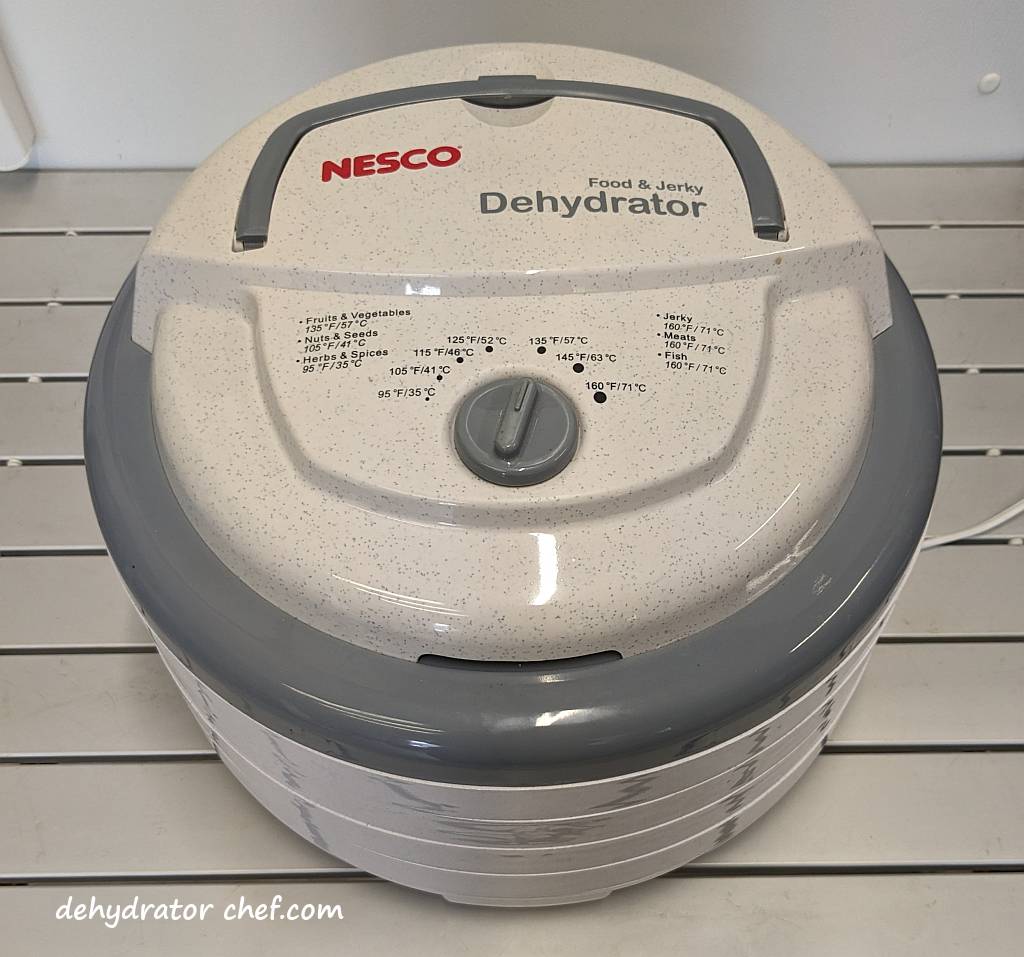
All you need to dehydrate these foods is a good quality food dehydrator. We use the Nesco food dehydrators. You can check out our food dehydrator guide to learn why we think Nesco offers the best bang for the buck. We believe this is the best food dehydrator for our long-term food storage needs.
For planning purposes, 1 to 2 medium-sized bell peppers will fill one of the Nesco 13.5-inch round dehydrator trays.
You’ll also need the removable mesh screen inserts; one will be needed for each of the dehydrator trays.
Supplies Needed for Dehydrating Bell Peppers
- Food dehydrator
- Removable mesh screen insert, one for each dehydrator tray
- Common kitchen tools such as cutting boards, chef’s knife, colander, etc.
- Canning jars with tight-fitting lids
- Wide-mouth canning jar funnel
- Desiccant packets for moisture control (optional)
Step 1. Process the Bell Peppers for Dehydration
When selecting bell peppers for dehydration, choose those that are firm, with smooth and shiny skin, preferably not too wrinkly, and without blemishes or soft spots that can’t be cut away.
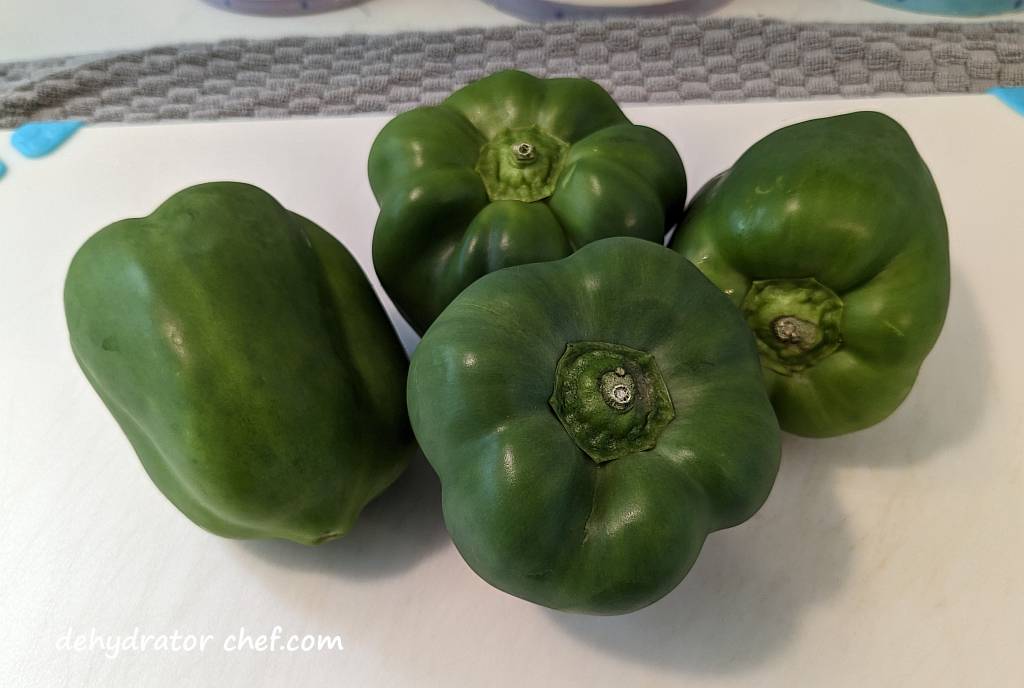
We start cleaning and rinsing the bell peppers under cold water to remove any soil or shipping residue.
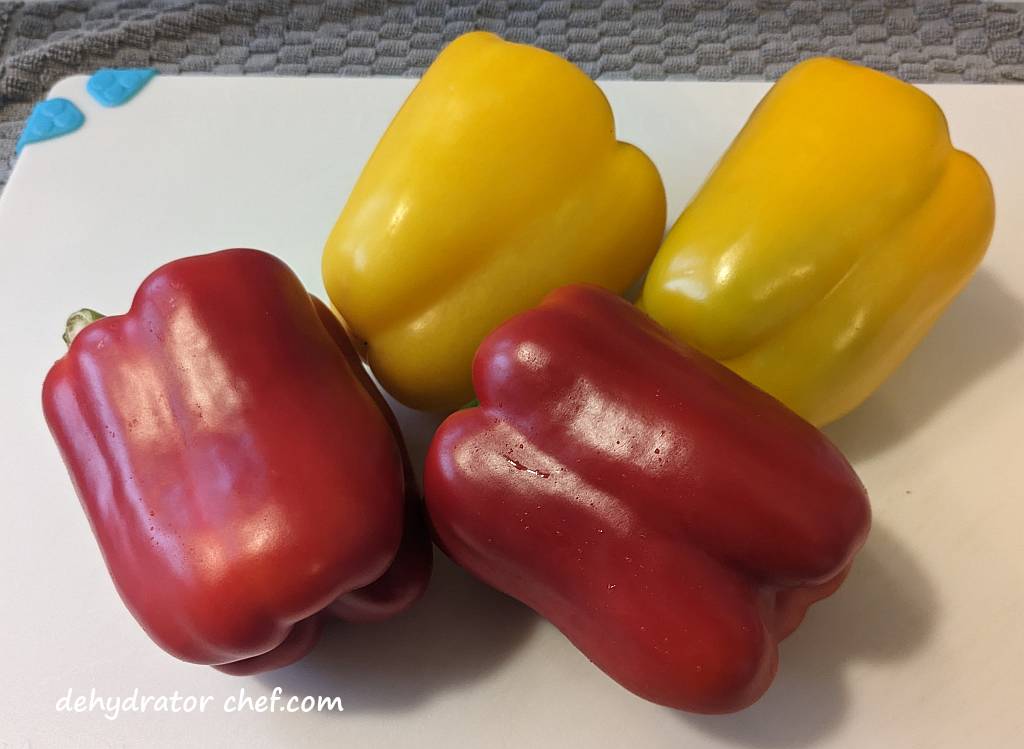
This is what we do; you might have your own method for processing bell peppers. Cut off the pepper top. Then, remove the seedy core from the middle of the bell pepper. Or, cut the peppers in half and then remove the core after cutting off the top. Choose a method that gets you there.
Next, cut the larger pepper pieces into strips, maybe 1/4 to 1/2 inch (6 to 12mm) wide or so.

Finally, chop each of the strips into equal-sized pieces. You end up with little squares of processed bell pepper. This will ensure that they will all dry evenly and at the same rate.
Don’t forget to process what you can use from the pepper top.
We aim for smaller pieces so that they will hydrate faster at mealtime. As such, we’ll settle for smaller pepper squares.
That’s it. Easy enough.
Step 2. Preparing the Dehydrator for Dehydrating Bell Peppers
We’ll need a removable mesh screen insert for each dehydrator tray.
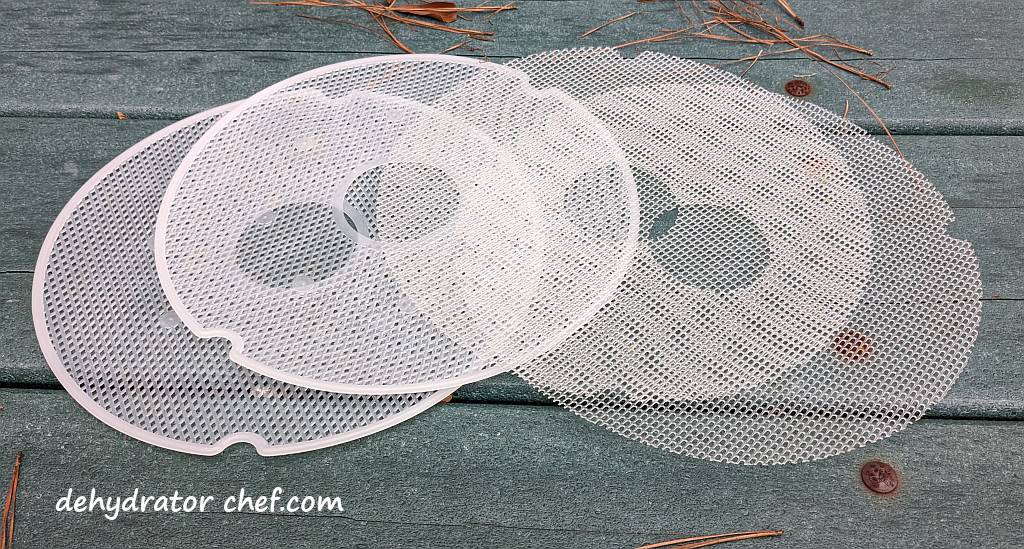
For today’s dehydrator project, we are using the Nesco Clean-A-Screen removable mesh screen inserts for sticky fruits and small food items that we are dehydrating today. They have over 2500 customer reviews with an average rating of 4.7 stars out of 5, which is evidence of a great product. Check out other Nesco food dehydrator products here.
Nesco Clean-A-Screens are removable and flexible mesh screen inserts with a distinct top and a bottom side. If you had a high-powered microscope, you would see the individual strands in the mesh screens have a triangle shape. The bottom side of the screen feels smooth. The top of the screen has a triangle point and feels rough as you rub your fingers across the mesh.
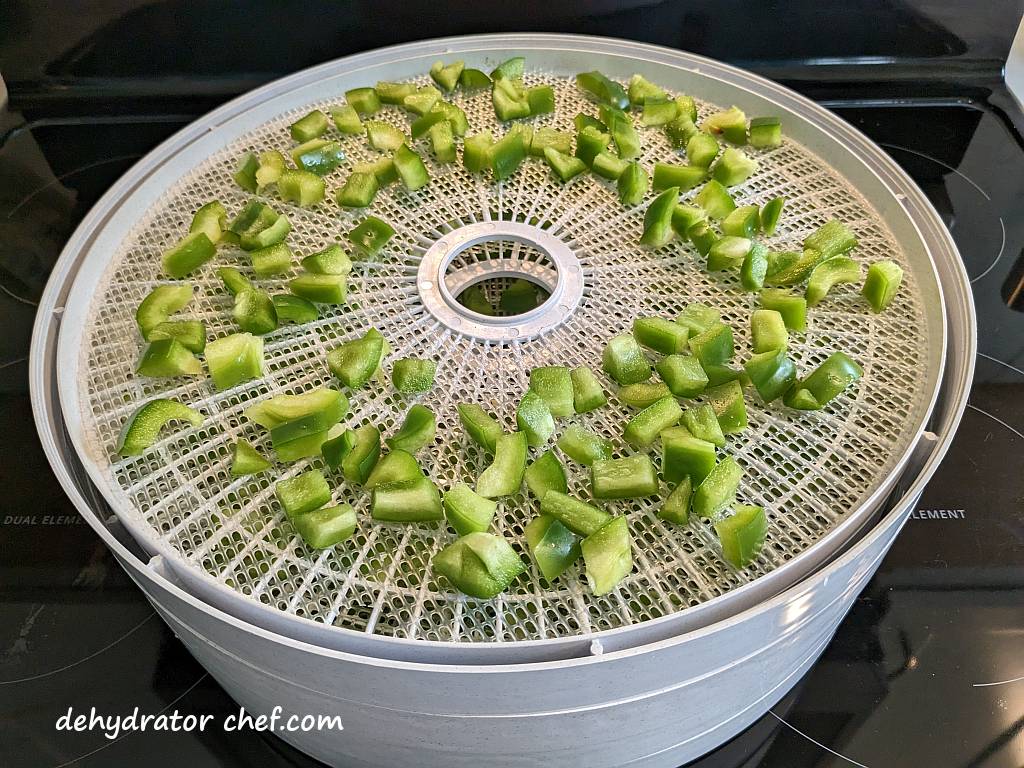
Spread out and layer the pepper pieces onto the removable mesh screen inserts. Try to spread the pepper pieces in a single layer for faster drying times.
For best results, don’t overcrowd the dehydrator trays. Leave some space between the pepper pieces to allow for airflow and drying.
For planning purposes, we probably average 1 to 2 processed medium-sized bell peppers for each of the Nesco 13.5-inch round dehydrator trays.
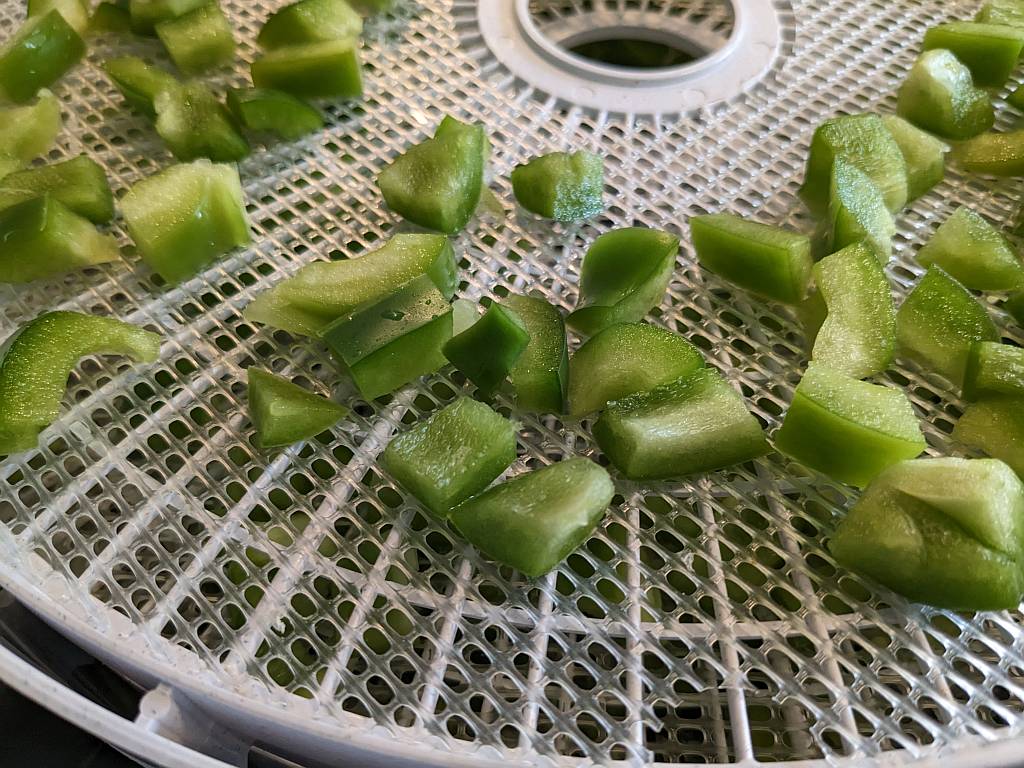
Step 3. Dehydrating Bell Peppers
For dehydrating bell peppers, set the dehydrator temperature to 135 °F (57 °C). I find that 18 to 24 hours is about the right amount of time. Peppers have a lot of water content.
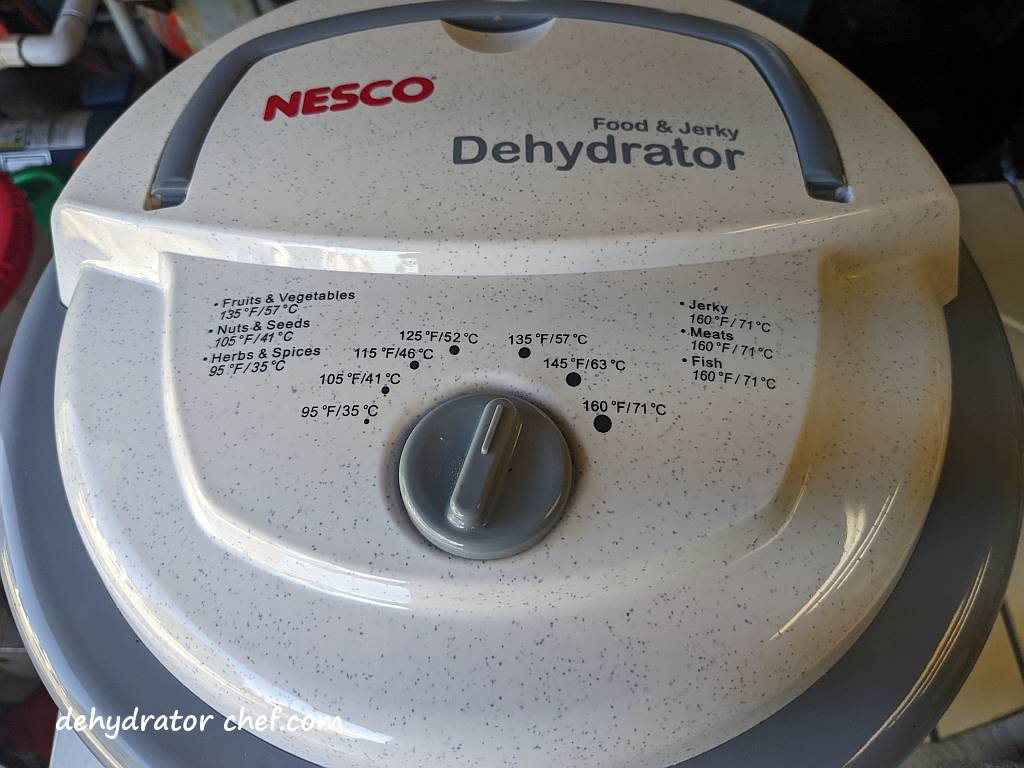
Following the manufacturer’s guidelines is crucial for getting optimal results from your food dehydrator. These guidelines provide specific details about the product that is not available elsewhere, including assembly instructions and product specifications. Reading these guidelines in full can help ensure that the dehydrator operates as intended. Failure to follow these instructions can lead to improper assembly or operation, which can affect the quality of the food you are dehydrating.
Of course, drying times are dependent on your food dehydrator, the ambient temperature and humidity, and how crowded you fill your trays. Remember to use drying times as a guide.
Step 4. When is the Dehydrated Bell Peppers Done
After 18 to 24 hours, the peppers should be fully dehydrated. If not, let it go another 2 to 4 hours and check again.
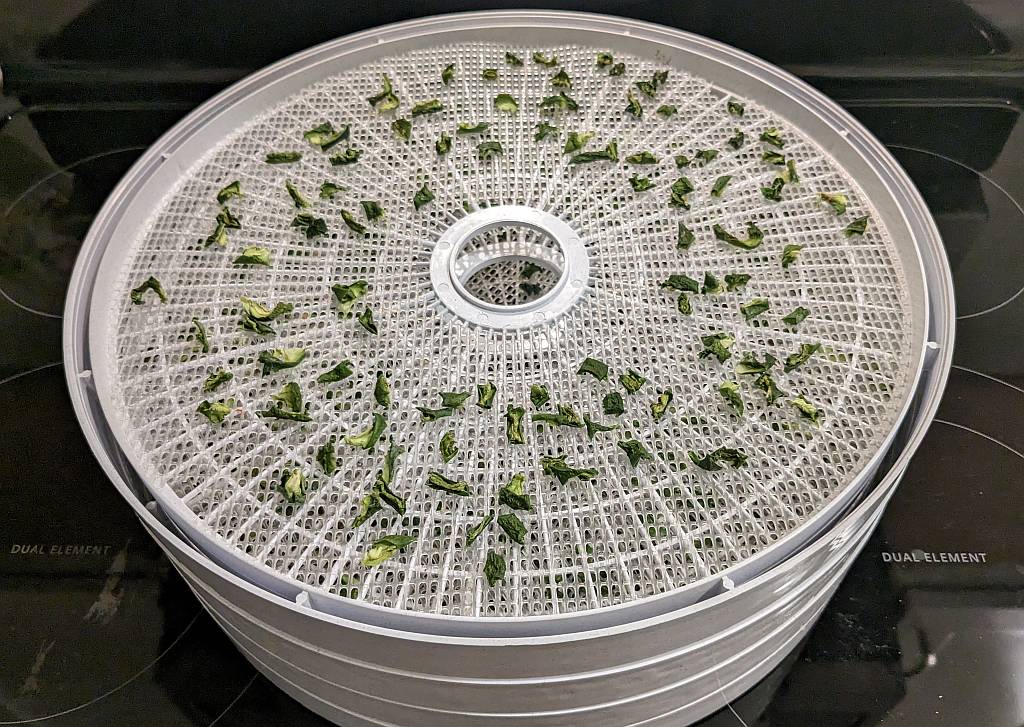
Drying times will vary depending on your dehydrator. Refer to your dehydrator owner’s manual for recommended temperatures and times for dehydrating specific foods. Remember to use drying times as a guide.
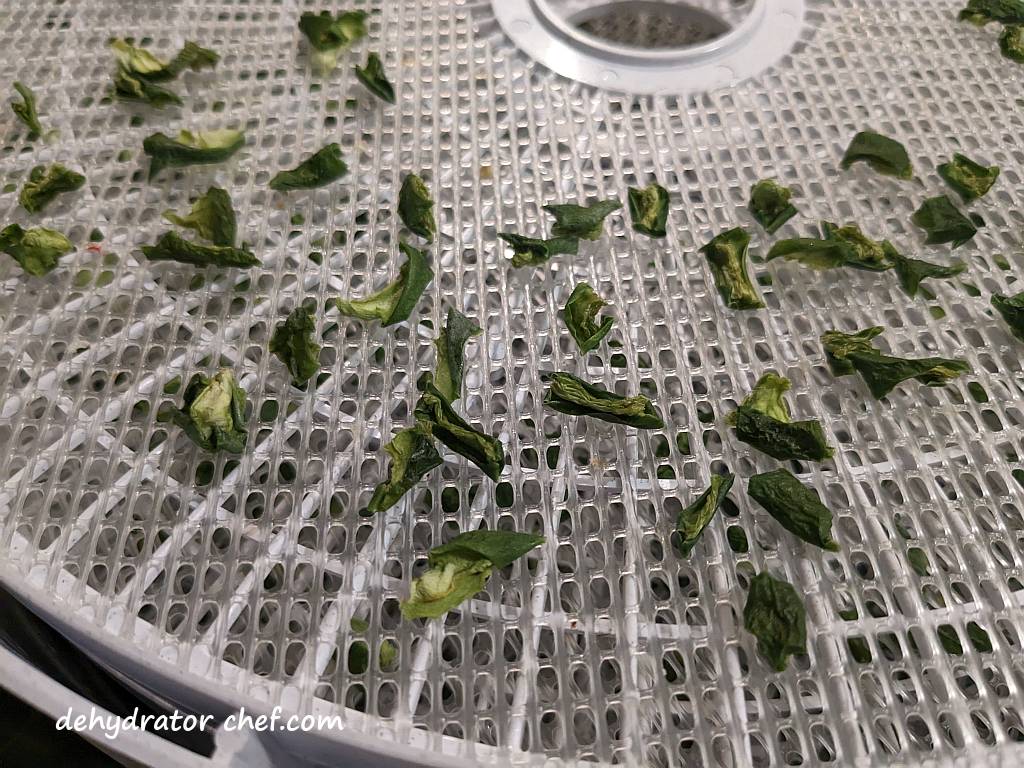
Warm bell peppers still in the food dehydrator will feel somewhat pliable, and you may believe they need more drying time. Simply unplug the dehydrator and let everything cool down. Then check again to be sure. The bell peppers pieces are brittle and should be hard little nuggets when done.
Step 5. Equalizing and Conditioning of the Dehydrated Bell Peppers
We always recommend letting food items cool completely after they have finished dehydrating and before packing them into an airtight storage container with tight-fitting lids for equalizing and conditioning. Warm food may cause sweating, which could provide enough moisture for mold to grow.
It does not take long for dehydrated food items to start hydrating from ambient household humidity. Do not leave dehydrated food items exposed to the elements any longer than necessary because of the increased risk of spoilage and mold growth.
After a short cooling period, loosely pack the dehydrated peppers into a clean, dry, insect-proof, and air-tight storage container. We use medium pint-size or quart-size clear canning jars for conditioning, whatever we might have on hand at the moment. Since the canning jars are clear, it’s easy to see what’s inside.
A wide-mouth canning jar funnel is handy for the task of getting dehydrated food from the trays into the canning jars with minimal spillage. It’s not a necessity, but having one does make the job easier and faster. If you need one, check them out on Amazon.
When the dehydrated pepper pieces are removed from the dehydrator, the remaining moisture may not be distributed equally among all of the pieces because of their location and position in the dehydrator. Equalizing and conditioning is a process for freshly dehydrated foods that ensures any residual moisture remaining in any piece is spread or equalized among all the other pieces in the batch. Let the dried peppers equalize and condition in the storage container for 7 to 10 days.
Every day, check the jar for moisture. Roll the jar contents around and note any clumping or sticking. If seen, put the contents back on the dehydrator for several more hours. Since canning jars are clear, it’s easy to see what’s inside.
If you notice any mold at all, even the smallest bit, throw it all out. What you see are the mold spores finally blooming enough to make them visible. But there are more, even tinier mold spores in the rest of your jar that make your dehydrated food inedible. Toss it out, clean your gear, and start another batch.
Step 6. Storing Dehydrated Peppers
Use an appropriately sized canning jar for storage. The dehydrated peppers might keep up to 12 months. Exactly how long depends on food type, preparation, pantry storage conditions, and storage containers.
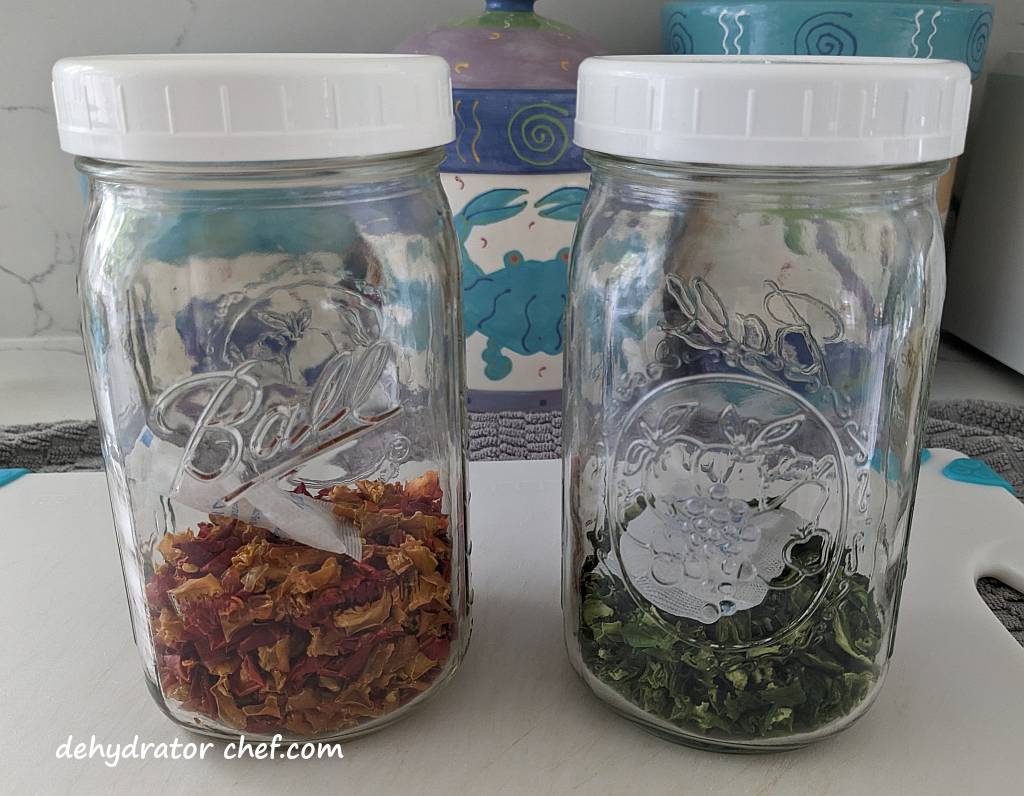
We’ll use a food-safe desiccant packet for moisture control because we live in a fairly humid area. For our pint-size or quart-size canning jars, we’ll use a single food-safe 5-gram desiccant packet. The desiccant packets will absorb any moisture and extend the shelf life of the dehydrated bell peppers.
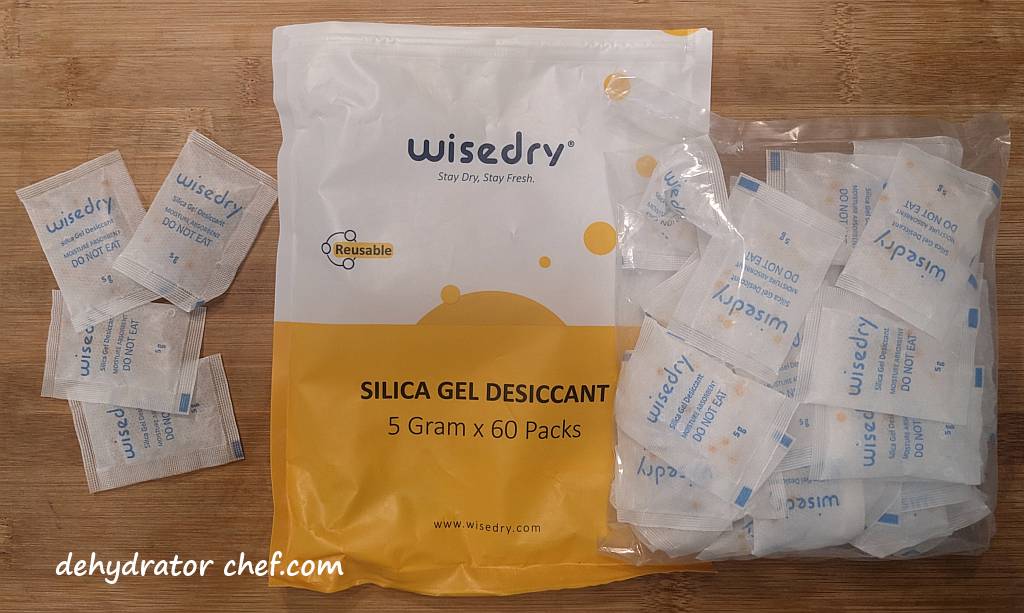
We use these inexpensive food-safe desiccant packets, which are available from Amazon. These 5-gram packets have over 5000 of mostly 4- and 5-star customer reviews, with an average of 4.7 stars out of 5. Our bag of 60 desiccant packets will last quite a while because they can be recharged and reused multiple times. Other food-safe sizes are available.
Lastly, attach or include a short note describing the jar contents and the date the product was dehydrated. The label identifies the canning jar contents, and the date helps with the rotation schedule. A first-in, first-out rotation helps us to use items that have been on the shelf the longest, so we’re using the oldest food first. This method helps us maintain the integrity of dehydrated products. The note also lets me know where to go in my dehydrator logbook if I want to make an update.
Hydration
Hydrate the dried peppers using a 1-to-1 ratio of dehydrated pepper to water. Peppers hydrate faster using boiled water. Plan on at least 15 to 20 minutes to fully hydrate.
If you’re supplementing store-bought freeze-dried meals as we do, just add a bit more boiling water to the food pouch. Use the same 1-to-1 ratio of dehydrated peppers to water and account for the extra time. Optionally, hydrate the dried peppers separately and then mix everything together.
Weights, Measures, and Serving Sizes
Summarizing the notes from our dehydrator logbook, green bell peppers lose more weight when dehydrated than yellow, orange, and red bell peppers. This is due to the sugar content. Green bells have less sugar than their ripened counterparts.
Approximately 100 grams of green bell pepper will dehydrate to about 6 grams.
Approximately 100 grams of red or yellow bell pepper will dehydrate to about 7 grams. Yeah, not really much of a difference.
Dehydrated Green Bell Pepper Nutrition Information
Serving Size: 6 grams | Calories: 20 kcal | Total Fat: 0 g | Saturated Fat: 0 g | Cholesterol: 0 mg | Sodium: 2 mg | Carbohydrate: 5 g | Dietary Fiber: 1 g | Sugar: 2 g| Protein: 1 g
Dehydrated Red, Yellow, and Orange Bell Pepper Nutrition Information
Serving Size: 7 grams | Calories: 26 kcal | Total Fat: 0 g | Saturated Fat: 0 g | Cholesterol: 0 mg | Sodium: 4 mg | Carbohydrate: 6 g | Dietary Fiber: 2 g | Sugar: 4 g| Protein: 1 g
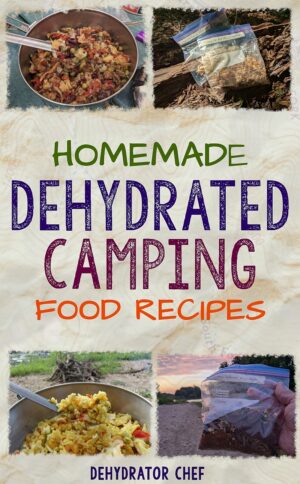 | The Dehydrator Chef Book Available only on Amazon.com You’ll find step-by-step instructions for 26 homemade dehydrated camping meals. Many recipes are only available in this book. Grab yourself a copy today. |
Insider Tips
Besides dehydrated meal recipes found here on this website, add dehydrated peppers to any of your favorite freeze-dried food pouches for a bit of flavor.
Store your dehydrated bell peppers in a cool, dry, and dark place to prevent them from losing their flavor and color. You can also vacuum seal and freeze them for extra protection against moisture and air.
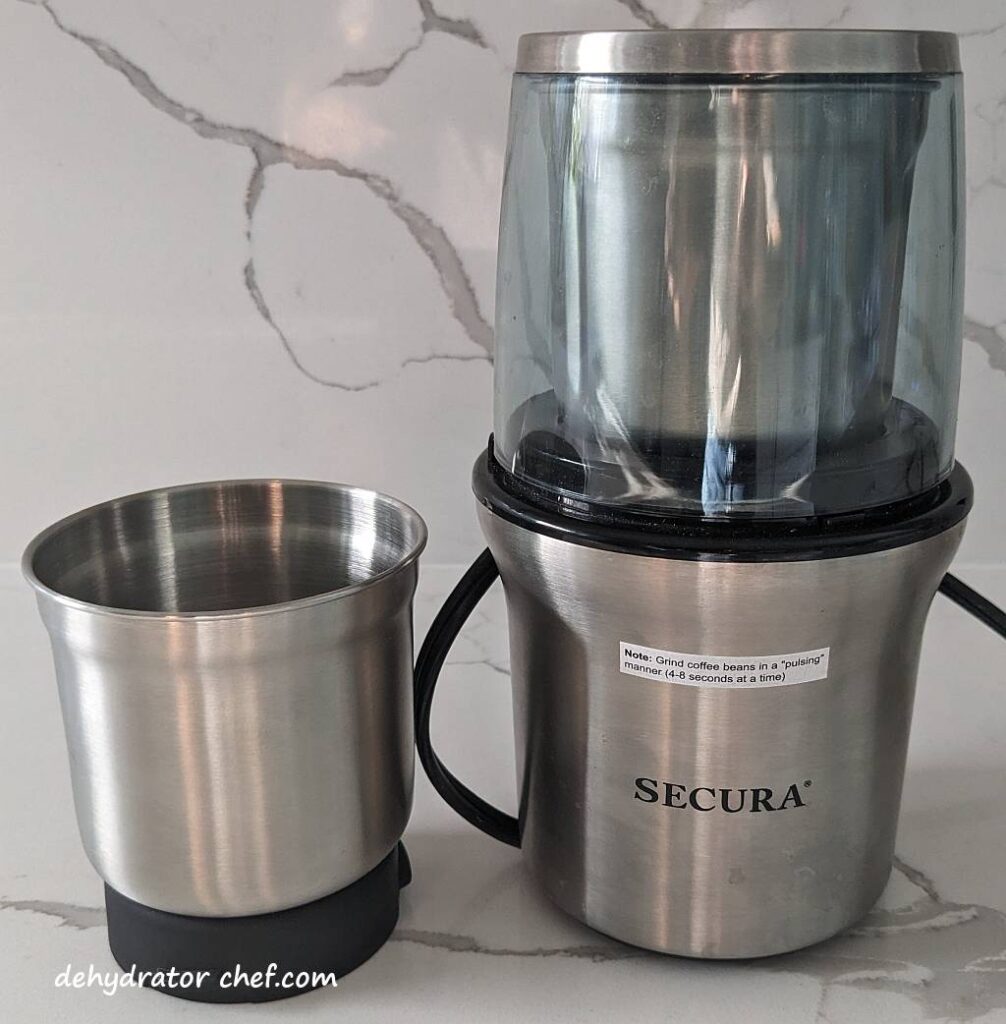
Consider using a spice grinder to make a spice powder. This is the spice grinder we use, it’s available at Amazon.com. It has close to 4,000 customer reviews, with an average of 4.4 stars out of 5. It comes with 2 grinding bowls, a 2-blade grinder, and a 4-blade chopper. It’s also easy to clean out the spice residue when you’re finished.
Smoke some red peppers to make homemade paprika. We’ll talk about wood-smoking peppers in another post. It’s fun and easy to do and great to have a variety on hand.
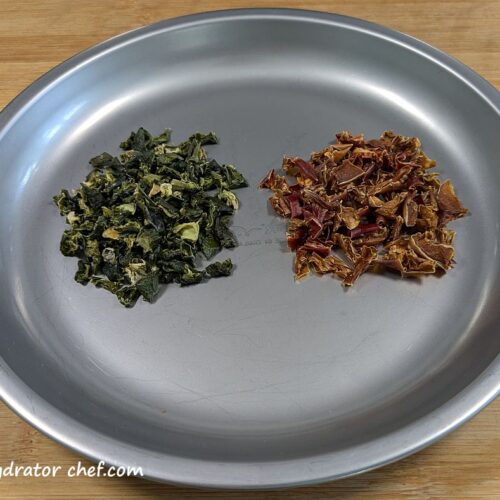
How to Dehydrate Bell Peppers
Equipment
- Removable mesh screen insert (one for each dehydrator tray)
- Common kitchen tools (including cutting boards, chef's knife, spatula, colander, etc.)
- Canning jars with tight-fitting lids
- Desiccant packets for moisture control (optional)
Ingredients
- large bell peppers (green, red, yellow, or orange)
Instructions
Process the Bell Peppers
- Rinse the peppers to remove any debris or shipping residue.large bell peppers
- Slice off the stem end and remove the seed pod from the peppers.
- Process the peppers by cutting them in half from top to bottom, then into strips, and finally into bite-sized pieces.
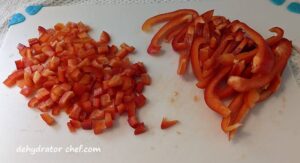
Prepare the Dehydrator
- Spread and layer the processed bite-sized pepper pieces on the removable mesh screen inserts. If it’s too crowded, prepare another tray.
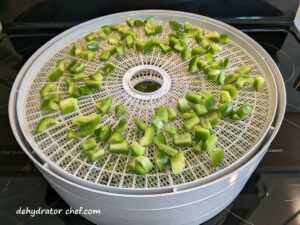
Dehydrate the Bell Peppers
- To save some time, you can start dehydrating the bell peppers by setting the initial drying temperature to 160 °F (71 °C) for 2 hours. Then dial the temperature back to 135 °F (57 °C) until dry, approximately 18 to 24 hours.
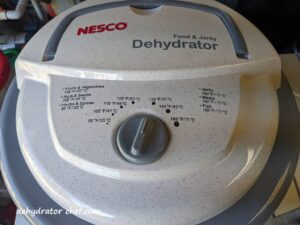
When are the Dehydrated Bell Peppers Done
- Fully dried, the bell pepper pieces are brittle and should be hard little nuggets when done.
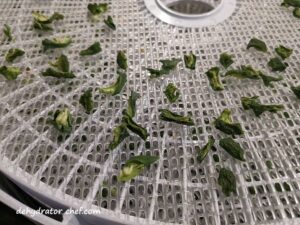
Equalizing and Conditioning the Dehydrated Bell Peppers
- After a short cooling period, loosely pack the dried peppers into a clean, dry canning jar with a tight-fitting lid, leaving some headspace.

- Every day, for 7 to 10 days, check the jar for moisture. Roll the jar contents around and note any clumping or sticking. If seen, put it all back on the dehydrator for several more hours.
- If you notice any mold at all, even the slightest bit, throw it all out.
Storing the Dehydrated Poblano Peppers
- Use appropriate-sized canning jars for storage. Depending on how well you dehydrate it and your pantry storage conditions, the dehydrated bell peppers should keep for at least 12 months.
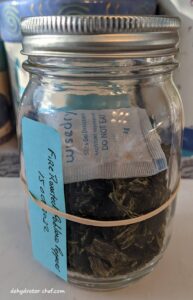
- An optional food-safe desiccant packet will aid with moisture control and enable a longer shelf life.

- Attach or include a label describing the jar contents and the date the product was dehydrated. The label identifies the canning jar contents, and the date helps with the rotation schedule. A first-in, first-out rotation helps us to use items that have been on the shelf the longest, so we're using the oldest food first.
Notes
Nutrition
Nutrition information is only an estimate and may differ depending on the ingredients you use.
